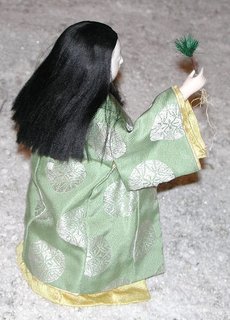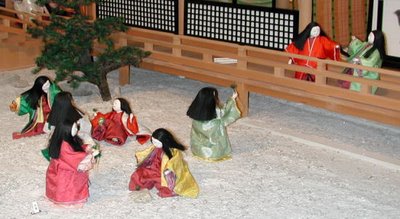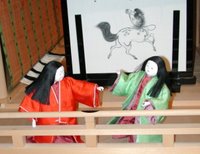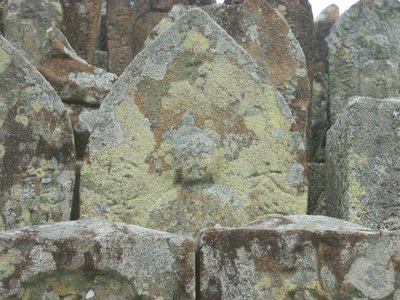:::::::::::::::::::::::::::::::::::::::::::::::::::::::::::::::::::::::::::::::::::::::::::::::::::::
Tea Ceremony Saijiki
茶道の歳時記
:::::::::::::::::::::::::::::::::::::::::::::::::::::::::::::::::::::::::::::::::::::::::::::::::::::
a cup of tea
in my small room -
insects of autumn
Gabi Greve, 2005
:::::::::::::::::::::::::::::::::::::::::::::::::::::::::::::::::::::::::::::::::::::::::::::::::::::
- under construction -
The Japanese Tea Ceremony
(chadoo 茶道, cha no yu 茶の湯),
the Way of Tea, has many seasonal events.
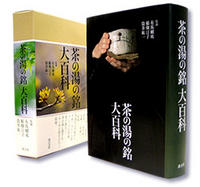
茶の湯の銘大百科
季節の言葉に見られる美しい日本語 。。。[稲畑汀子]
Great Dictionary about the Tea Ceremony
One of the authors is Inahata Teiko, the Haiku Master.
http://tankosha.topica.ne.jp/special/bookfair/2005_07/book1.html
:::::::::::::::::::::::::::::::::::::::::::::::::::::::::::::::::::::::::::::::::::::::::::::::::::::
Sasaki Sanmi, "Chado: The Way of Tea -- A Japanese Tea Master's Almanac",
translated by Shaun McCabe and Iwasaki Satoko, foreword by Shen Soshitsu XV
(Tuttle, 2002)
The book is very pricy, but for those interested in both chado and haiku, it is a very worthwhile investment. The book is highly idiosyncratic, but gives a good idea of how a spcecific tea-master's mind worked (1893-1969), and includes lengthy sections on foods and other
seasonal items, month by month. He was also a recognized haiku master, and the book includes many haiku, with somewhat awkward translations.
Unlike the Japanese book cited above, this one is less concerned with universals of chado, more with one specific person's approach to it all.
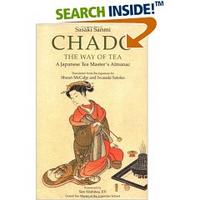
:::::::::::::::::::::::::::::::::::::::::::::::::::::::::::::::::::::::::::::::::::::::::::::::::::::
The Japanese tea ceremony is usually celebrated is a separate room or house, the Tea Ceremony Room, chashitsu 茶室.

This tea room of the temple Ginkaku-Ji in Kyoto is said to be the first of its kind in Japan.
I love
My hut
At the foot of the Moon-awaiting Mountain
And the reflection
Of the sinking sky
Shogun Ashikaga Yoshimasa (1436-1490) ... and more about this place.
. Kyoto - Higashiyama Culture .
Ginkaku-Ji 銀閣寺, Yoshimasa 足利義政, Doojinsai 同仁斎
- - - - -
yoojibashira 楊枝柱 "toothpick pillar"
The corner pillar of the host's mat is partly hidden.
jojibashira

. tsumayooji (tsumajoji) 爪楊枝 toothpick .
:::::::::::::::::::::::::::::::::::::::::::::::::::::::::::::::::::::::::::::::::::::::::::::::::::
Homepage of the Urasenke 裏千家のHP
http://www.urasenke.or.jp/textm/headq/soke/
© Urasenke Homepage Canada
裏千家の家元、千宗室
Interview with Sen Soshitsu (Sen Sooshitsu) Present Iemoto
"Chanoyu: an Anthropological Approach to Tea,"
Jennifer Anderson
... ... ...
Yabunouchi Tea School 藪内流 WKD
Sen Sotan 千宗旦 (1578-1658)
Sootangitsune 宗旦狐 Sotan the Fox
Matsudaira Fumai (松平不昧) and the Matsue Tea Ceremony
Matsudaira Harusato (松平治郷) (1751-1818)
:::::::::::::::::::::::::::::::::::::::::::::::::::::::::::::::::::::::::::::::::::::::::::::::::::
Teacups chawan 茶碗 are very important in the tea ceremony.
Here are some from Raku Kichizaemon XV
樂 吉左衛門
楽茶碗 Tea Cups in the RAKU style WKD
........................................
The rain stayed away
This night was hot and moonie
Raku is the best
--Sarah M. and Natalie C.

Read more here:
© Annual Raku firing with Ellis students
-- tea ceremony and haiku
. Tea cups and pots - Dragon Design .
:::::::::::::::::::::::::::::::::::::::::::::::::::::::::::::::::::::::::::::::::::::::::::::::::::

Lid stand (futa oki, futaoki 蓋置き)
To keep the lid of the water kettle off the floor.
This small item made of various materials, including porcelain, bamboo or carved wood.
To give it a seasonal touch, in winter a pine cone is used, in summer a butterfly.
CLICK for more LINKS !
. Tea Kettles 茶釜 chagama .
. chasen 茶筅 / 茶筌 / 茶せん tea whisk .
Kaishi 懐紙 "pocket paper"
:::::::::::::::::::::::::::::::::::::::::::::::::::::::::::::::::::::::::::::::::::::::::::::::::::::
hanebooki, hane-booki 羽根ぼうき / 羽箒
feather to ritually clean the hearth, feather broom
(habooki 羽箒) Federbesen
. . . CLICK here for Photos !
炭斗の羽箒に来る鼠かな
sumitori no habooki ni kuru nezumi kana
she comes to the
feather broom in the coal basket -
this mouse
Shiwasu san 師走
:::::::::::::::::::::::::::::::::::::::::::::::::::::::::::::::::::::::::::::::::::::::::::::::::::::
Sweets served for the tea ceremony,
chagashi 茶菓子
tea cakes, teacakes, Teekuchen
omogashi 主菓子, main cake for a tea ceremony
The cakes bring the seasons into the tearoom. Their names are also made to reflect the season and to show the poetic associations of olden times. Many are named after famous poems.
WAGASHI ... Sweets SAIJIKI
*****************************
Worldwide use
China
Gongfu Cha
The place of tea time in England, tea ceremony in Japan, gongfu cha in China... show that tea is more than a drink. It's a social activity. One that let's us exchange and share a common feeling with friends, family or even strangers.
Chinese Tea Masters
External LINK by Stéphane Erler
:::::::::::::::::::::::::::::::::::::::::::::::::::::::::::::::::::::::::::::::::::::::::::::::::::
Germany
Jahreszeiten im Teeweg , Jahreszeitenworte
by Gerhardt Staufenbiel, Urasenke Teelehrer (Teamaster)
Read the German explanations here:
Jahreszeiten im Teeweg, by Gerhardt Staufenbiel
"Was ist der geheime Hintergrund für die Verwendung des Furo im Sommer und des Ro im Winter?"
"Ruf im Sommer das tiefe Empfinden einer kühlen Frische und im Winter das einer geborgenen Wärme hervor.
Leg die Holzkohle so, daß sie das Wasser richtig erhitzt und bereite einen Tee, der erfreut - das ist das ganze Geheimnis!"
Sen no Rikyû
The German text is found here:
http://www.teeweg.de/de/kisetsu/jahreszeiten.html
*****************************
12 Months in the Tea Ceremony
kigo for the New Year

hatsugama 初釜 "first use of the kettle"
First tea ceremony of a new year.
..... hatsu chanoyu 初茶湯(はつちゃのゆ)
..... kamahajime 釜始(かまはじめ)
..... tatezome 点初(たてぞめ)
..... hatsu temae 初点前(はつてまえ)
..... temae hajime 点茶始(てんちゃはじめ)
..... chanoyu hajime 茶湯始(ちゃのゆはじめ)
New year decoration with willow branches
kake yanagi 掛柳 (かけやなぎ)

hatsu chashaku 初茶杓 first use of the tea scoop
..... hatsu kezuri 初削/削初 first carving
A new scoop is carved and used at the first tea ceremony of the year.
hikizome 挽初 (ひきぞめ)
first grinding of powdered tea
..... cha no hikizome 茶の挽初(ちゃのひきぞめ)
Obukucha おぶくちゃ
First tea ceremony of the new year. Using the first well water (wakamizu) and heating the hearth for the first time. A quiet ceremony for the tea master and his family.
. Good Health (Luck) Tea, fukucha 福茶 .
..... oobuku, oofuku 大服
..... oofukucha, oobukucha 大福茶 , 皇服茶
..... ofukucha 御福茶
. First drawing of Well Water (wakamizu 若水) .
Tenarai hajime : Raku family of tea ceramics
手習始め. 楽家.
Introducing the Raku Family.
.................................................................................
一月 Ichigatsu - JANUARY
茶入 Chaire - Behälter für den dicken Tee - Containers for thick tea
来福 Raifuku
初草 Hatsu Kusa
茶杓 Chashaku - Teelöffel - Tea Scoops
. 蓬莱山 Horai San (hoorai san).
千代の光 Chiyo no Hikari

茶碗 Chawan - Teeschalen - Tea Bowls
雲海 Unkai, Sea of clouds
瑞雲 Zuiun
:::::::::::::::::::::::::::::::::::::::::::::::::::::::::::::::::::::::::::::::::::::::::::::::::::::::::::::::::::::::::::::::::::
二月 Nigatsu - February
茶入 Chaire - Container for powdered tea
山の神 Yama no Kami, God of the Mountains
暮雪 Bosetsu, Much Snow
茶杓 Chashaku - Tea scoop
籬の雪 Magaki no Yuki
春の水 Haru no Mizu, water of spring
洗心 Sen Shin senshin
茶碗 Chawan
雪国 Yukiguni, Snow country
夜寒 Yosamu, Cold Night
東雲 Shino Nome
宿の梅 Yado no Ume, Plums at the resthouse
akatsuki no chaji 暁の茶事 "dawn tea ceremony"
A tea ceremoniy held in the coldest season of the year. It starts at 4 a.m. and the participants enjoy the dawn of the new day. It starts with candle light and slowly things become more visible as the day breakes and light comes through the small windows.
:::::::::::::::::::::::::::::::::::::::::::::::::::::::::::::::::::::::::::::::::::::::::::::::::::::::::::::::::::::::::::::::::::
三月 Sangatsu - March
. Rikyuu Ki 利休忌 Rikyu Memorial Day.
Memorial ceremony of the death day of Sen Rikyu.
tsurigama 釣釜 (つりがま) hanging kettle
. . . CLICK here for Photos !
quote
The Tsurigama is a slightly narrower kettle which is hung from a chain exactly above the Ro charcoal pit. The Kan rings are different from those used when removing a normal Kama from the fire. The chain, the rings, and the handle are available for reasonable prizes to extremely expensive sets with a name made by famous smiths and come in their own box.
source : the-japanese-tea-ceremony.blogspot.jp
:::::::::::::::::::::::::::::::::::::::::::::::::::::::::::::::::::::::::::::::::::::::::::::::::::::::::::::::::::::::::::::::::::
四月 Shigatsu - April
. "sweet tea", amacha 甘茶 (あまちゃ) .
"water with five scents", gokoosui 五香水(ごこうすい)
"water of five colors, goshiki no mizu
五色の水(ごしきのみず)
Buddha's Birthday on April 8
. hachijuuhachiya 八十八夜
eighty-eighth day from the beginning of spring.
The best time for picking tea leaves
:::::::::::::::::::::::::::::::::::::::::::::::::::::::::::::::::::::::::::::::::::::::::::::::::::::::::::::::::::::::::::::::::::
The Haiku Summer starts in May.
humanity kigo for all summer
furocha 風炉茶 (ふろちゃ)
tea ceremony with the furo brazier
..... furo temae 風炉手前(ふろてまえ)
hatsuburo (shoburo) 初風炉(はつぶろ) first use of the furo brazier
The furo brazier is used from May to November.
asa cha no yu 朝茶の湯 (あさちゃのゆ)
tea ceremony in the morning
natsu cha no yu 夏茶の湯(なつちゃのゆ)
tea ceremony in summer
..... natsu temae 夏点前(なつてまえ)
asacha 朝茶(あさちゃ)"tea in the morning"
asa chaji 朝茶事
Tea ceremonies held in the cool hours of the early morning, beginning at 6, before the heat of day begins. Light refreshments are served with the tea.

meisuidate 名水点(めいすいだて)
entertaining with famous water
Tea masters especially in Kyoto would go to a famous well to scoop water. They use a special purified wooden container to transport the water.
. . . CLICK here for Photos !
natsujawan 夏茶碗(なつぢゃわん) tea cup for summer
The pattern will bring a feeling of coolness.
. . . CLICK here for Photos !
. Saidaiji Oochamori, oo-cha mori
西大寺大茶盛 (さいだいじおおちゃもり)
serving big cups of green tea at temple Saidai-Ji
..... oochamori 大茶盛(おおちゃもり) "big teacup"
:::::::::::::::::::::::::::::::::::::::::::::::::::::::::::::::::::::::::::::::::::::::::::::::::::::::::::::::::::::::::::::::::::
五月 Gogatsu - May
新茶 shincha, new tea, fresh green tea
茶摘み chatsumi, picking tea leaves
茶摘歌 chatsumi uta, song of the tea pickers
In olden times, girls dressed in special kimono and headgear would go out to pick the tea leaves.
Click HERE to look at photos.
山門を出れば日本ぞ茶摘うた
sanmon o dereba nihon zo chatsumi uta
outside the temple gate
it's Japan again!
the song of tea pickers
Read a discussion of this haiku:
Tr. Gabi Greve
:::::::::::::::::::::::::::::::::::::::::::::::::::::::::::::::::::::::::::::::::::::::::::::::::::::::::::::::::::::::::::::::::::
六月 Rokugatsu - June
Ryô Ichimi 涼一味 ryooichimi . Coolness
The head of the Urasenke Tea Ceremony, Sen Soshitsu (Sen Sooshitsu) 裏千家の家元、千宗室, talked about ways to stage the coolness, for example using a large fresh green leaf as cover of the water container (habuta 葉蓋) or wringing the little linen cleansing cloth in a way it produces the fresh sound of clear water (arai jakin 洗い茶巾). The intention is to create an aesthetically cool feeling, not to physically cool anything.
Read more:
Sen Soshitsu about Stageing of Coolness in the Tea Ceremony.
meisuidate 名水点 Using famous well water for the tea
tsurube mizusashi つるべ水差し square cedar box water container
Esai-ki 英西忌 Memorial Day of Eisai
Kenchû-ki 剣仲忌 (Kenchuu) Memorial Day
Ômi-jingû Schrein Kencha 近江神宮献茶 (Oomi Jinguu)
. Koorin-ki 光琳忌 Korin Memorial Day .
Ogata Korin, Ogata Koorin 尾形光琳 (1657 - 1716)
. Oribe-ki 織部忌 Oribe Memorial Day .
Chôandô-ki (Chooandoo)
Furuta Oribe 古田織部 (1544 -1615)
Rokugatsu no harae 六月の戒
..... Summer Purification Ceremony (nagoshi)
:::::::::::::::::::::::::::::::::::::::::::::::::::::::::::::::::::::::::::::::::::::::::::::::::::::::::::::::::::::::::::::::::::
七月 Shichigatsu - July
. Kenchabune 献茶舟(けんちゃぶね) boat for ritual tea ceremony .
at the Tenmangu Shrine Festival in Osaka 天満祭
flowers arranged taking turns turn, mawaribana まわりばな 廻り花、回り花
Each participant has to put one flower in the vase for a flower arrangement. The vase is then placed in the tokonoma. The flower arrangement has to match the hanging scroll theme. The vase is usually made of bamboo with a cut at the top.
:::::::::::::::::::::::::::::::::::::::::::::::::::::::::::::::::::::::::::::::::::::::::::::::::::::::::::::::::::::::::::::::::::
The Haiku Autumn starts in August.
八月 Hachigatsu - August
Hassaku-gama 八朔釜 Tea kettle used at the Hassaku ceremony.
Hassaku Harvest Festival, Hassaku sai, Hassaku no Iwai Japan
.................................................................................
Kado-cha 門茶 "tea at the gate"
..... settai 摂待
giving tea as alms at the temple gate
From the first of the 7th lunar month to the 24th.
Tea is prepared at the gate and given to monks and pilgrims. Sometimes a full tea ceremony with food is given as alms.
. o-settai, settai 摂待 giving alms to henro pilgrims .
摂待や猫がうけとる茶釜番
settai ya neko ga uketoru chagama ban
giving tea to the pilgrims -
the cat is also served
by the teakettle caretaker
Kobayashi Issa
:::::::::::::::::::::::::::::::::::::::::::::::::::::::::::::::::::::::::::::::::::::::::::::::::::::::::::::::::::::::::::::::::::
九月 Kugatsu - September
Naka-oki 中置
Koogetsu ki 月江忌 Kogetsu Memorial Day (Gekkoo)
Abt Koogetsu Soogan 江月宗玩 (1574 - 1643), temple Daitoku-Ji 大徳寺.
Uji no Cha-matsuri 字治の茶祭 Tea Festival at Uji
source : chamatsuri
. Different types of Green Tea from Japan .
Bashoo Ki 芭蕉忌 Bashoki, Basho Ki Matsuo Basho Memorial Day
MORE - hokku about drinking tea with
. Matsuo Basho 松尾芭蕉 - Archives of the WKD .
Yasukuni-jinja Kencha 靖国神社献茶, Tea Ceremony at Yasukuni Shrine
:::::::::::::::::::::::::::::::::::::::::::::::::::::::::::::::::::::::::::::::::::::::::::::::::::::::::::::::::::::::::::::::::::
十月 Juugatsu - October
Nagori no chaji 名残の茶事
Furo-nagori 風炉名残 "parting with the furo"
At the end of autumn, the last tea of this year is drunk in rememberance of the warmer season. Now the winter will soon start.
At the end of October, the furo 風炉 is put away and replaced by the ro 炉.
A special tea ceremony is held to part with the hearth for the next half year.
Ichio-ki 一翁忌 Ichio Memorial Day
(around October 19)
A tea ceremony on the anniversary of the death of the tea master Sen Ichio Soshu 一翁宗守 (1593~1675, the fourth generation from Rikyu.
He was the founder of the tearoom Kankyuan 官休庵(Kankyuu-An).
:::::::::::::::::::::::::::::::::::::::::::::::::::::::::::::::::::::::::::::::::::::::::::::::::::::::::::::::::::::::::::::::::::
十一月 Juuichigatsu - November
Robiraki 炉開き"Opening the hearth"
irori hiraki 囲炉裏開く(いろりひらく)"opening the open hearth"
The hearth 炉 is opened for the first time since April. Tea for this cereomny is prepared with tea powder made from leaves freshly picked that summer.
This hearth, ro, will be used from now until the following April.

nurirobuchi 塗炉縁 ぬりろぶち fuchi edge of the hearth
kijirobuchi 木地炉縁(きじろぶち)wooden edge around the hearth
a square hearth protection. Some of famous temples are decorated with laquer and inlay.
Kuchikiri no chaji 口切の茶事 (くちきり) opening the tea jar
kuchikiri, kuchi kiri 口切(くちきり)
kuchikiri chakai 口切茶会(くちきりちゃかい) Kuchikiri tea ceremony
now around November 16
It used to be the 30th day of the 9th lunar month.
Tea leaves picked in early summer are packed inside jars and mature until November. Now the jars are opened (kuchi kiri : open the mouth of the jar).
The leaves are then ground into powder for powdered green matcha.
At this tea ceremony, the tea is prepared using the first fresh powder.
. . . CLICK here for Photos !
Matsuo Basho remembers Sen Rikyu
and the kuchikiri ceremony in Sakai
. kuchikiri ni Sakai no niwa zo natsukashiki .
口切のとまり客あり峰の坊
kuchikiri ni tomarikyaku ari mine no boo
for the opening of the tea jar
there are visitors over night -
mountain retreat
. Tan Taigi 炭太祇 .
. . . . .
shiki matsuba 敷松葉 (しきまつば) spreading pine needles
:::::::::::::::::::::::::::::::::::::::::::::::::::::::::::::::::::::::::::::::::::::::::::::::::::::::::::::::::::::::::::::::::::
十二月 Juunigatsu - December
Kotohajime 事始
Preparations for welcoming the new year begin. Greetings for the year end are made on this day. Around December 11.
Joyagama 除夜釜
On New Year's Eve (joya), the family and close students of a tea master drink the final tea of the year in the tea master's home. The fire built at this time is used for the first Obukucha the following year on the next morning. Thus the tradition is continued from one year to the next.
Yobanashi no chaji 夜話の茶事 "Talking at nightfall"
Tea ceremonies are held in candlelight from nightfall until evening. Food is served and the cold and maybe snow can be enjoyed. It starts at 6 o'clock.
..... yobanashi 夜咄 (よばなし)
..... rohenbanashi 炉辺話(ろへんばなし)
..... yobanashi saji 夜咄茶事(よばなしさじ)
:::::::::::::::::::::::::::::::::::::::::::::::::::::::::::::::::::::::::::::::::::::::::::::::::::::
Each Month with its tea-related kigo
From a Japanese Saijiki
http://www.sadoukaikan.com/tea/saijiki.html
*****************************
Things found on the way
Daruma san, だるまさん 達磨さん、 the Indian Monk Bodhidaruma, practised Zazen for long hours. When he got sleepy, he cut off his eyelids and threw them away. Later he found a plant had grown out of them. He collected the leaves and brewed the first tea ... says the legend.
Daruma is closely related to tea for this reason !!!
Here is a special online museum for Daruma san only.
Daruma Museum Japan by Gabi Greve
The Old Tea Road from Yunnan to Lhasa .. Pu Erh Tea and Salt
茶葉古道(ちゃばこどう)
*****************************
HAIKU
NARACHA ... 奈良茶
Matsuo Basho was very fond of Naracha rice gruel served at Haikai Meetings.
侘びて澄め月侘斎が奈良茶歌
. wabite sume tsuki wabisai ga Naracha uta .
Matsuo Basho 松尾芭蕉 - Archives of the WKD
:::::::::::::::::::::::::::::::::::::::::::::::::::::::::::::::::::::::::::::::::::::::::::::::::::::
The Hundred Poems of Chanoyu 茶の湯百首
(92)
茶の湯には梅、寒菊に、黃葉落、靑竹、枯木、曉の霜
(The essence of) chanoyu (may be found) by (the contemplation of) these (images): the ume and the kan-giku; the scattering of the colored leaves, the (vitality of) green bamboo, and (the solitude and silence of a) leafless tree (in the depths of winter); the frost at dawn.
Daniel M. Burkus
source : chanoyu-to-wa
:::::::::::::::::::::::::::::::::::::::::::::::::::::::::::::::::::::::::::::::::::::::::::::::::::::
clear mind
viewing the garden
drinking tea
Gabi Greve, 2005
Inside the Zen gardens of Master Shunmyo Masuno
xxxxxxxxxxxxxxxxxxxxxxxxxxxxxxxxxxxxx
autumn solitude -
I share my cup of tea
with ALL of you !
Isn't the Internet a great place !
Click HERE to see my teapot philosophy !
Gabi Greve, September 2006
:::::::::::::::::::::::::::::::::::::::::::::::::::::::::::::::::::::::::::::::::::::::::::::::::::::
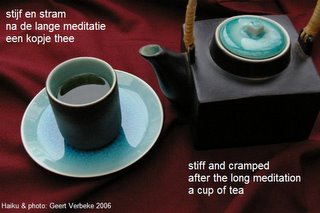
Geert Verbeke, January 2006
http://users.skynet.be/geert.verbeke.bowls
:::::::::::::::::::::::::::::::::::::::::::::::::::::::::::::::::::::::::::::::::::::::::::::::::::::
late spring -
the old kettle
still shines
Gabi Greve, April 2007
short history of the tea kettle
:::::::::::::::::::::::::::::::::::::::::::::::::::::::::::::::::::::::::::::::::::::::::::::::::::::

*****************************
Related words
Saijiki of Buddhist, Shinto and other Ceremonies and Events of Japan
The Old Tea Road from Yunnan to Lhasa
茶馬古道(ちゃばこどう) Chaba Kodo

:::::::::::::::::::::::::::::::::::::::::::::::::::::::::::::::::::::::::::::::::::::::::::::::::::::
[ . BACK to DARUMA MUSEUM TOP . ]
[ . BACK to WORLDKIGO . TOP . ]
- ##chanoyu #teaceremony -
:::::::::::::::::::::::::::::::::::::::::::::::::::::::::::::::::::::::::::::::::::::::::::::::::::::

